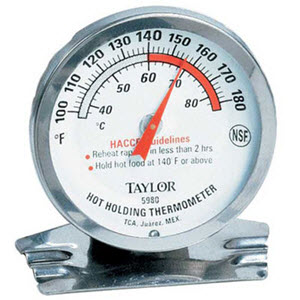The End of Time and Temperature Abuse
Posted on 2nd Mar 2018

What is referred to as "time and temperature abuse" is a leading cause of food poisoning. Time abuse refers to the fact that at a certain point, bacteria will start to grow in cooked foods such as meats, fish, pork, and poultry that have been left out at room temperatures. In about two hours, these bacteria can make food unsafe, potentially causing food poisoning if a person consumes it.
Temperature abuse occurs when food items are not refrigerated promptly for storage or after cooking, or are refrigerated, but not at the right temperature setting. In the US, commercial refrigerators should always be set at 40 degrees (F) or cooler.
According to most food safety experts, the best way to prevent time and temperature abuse and ensure that food is safe to serve, is by use of thermometers that are regularly checked. Fortunately, many different types of refrigerator and cooking thermometers have been developed; among them are the following:
Hanging thermometers: These should be installed in the warmest part of the refrigerator, usually near the door, as well as at the coldest point, generally at the back.
Bi-metallic stem thermometers: These thermometers measure temperatures from 0 degrees (F) to 220 degrees (F). They typically have a read-out dial and have been shown to be accurate to within plus or minus 2 degrees. To be used correctly, the entire sensor should be in the center of the food.
Digital (tip) thermometers: These are similar to stem thermometers, but the sensor is located near the tip. Because only a tip must be inserted into the center of food, these thermometers can be used to measure temperature in both thick and very thin foods.
Oven thermometers: These should be placed next to the food item being cooked. If the dial setting on the range is set at 350 degrees, the oven thermometer will indicate if the temperature inside the oven is indeed 350 degrees.
Infrared thermometers: These thermometers use infrared technology to determine temperature readings of food. One of their significant features is that they help reduce any risk of cross-contamination. The unit never is in contact with food. However, the accuracy of infrared thermometers can vary for a variety of reasons. Because of this, most food service professionals advise that these systems should not be used to measure "final" temperatures of food being cooked.
Even though there may be some question marks concerning the infrared thermometers, these thermometers can be used to help foodservice professionals ensure the food they cook, refrigerate, and serve their guests is safe. However, as mentioned earlier and according to a report from Iowa State University, the safety of food items is very dependent on "how often thermometers are checked, and who is responsible for checking them."
Herein lies a very serious problem and a key cause of food poisoning. We all know how busy a commercial kitchen can be. On top of that, managers are always contending with staff absenteeism and turnover. So, checking these thermometers on a regular basis often falls by the wayside.
None of these thermometers discussed can notify managers or kitchen staff if there is a temperature problem. This is why many restaurants and commercial kitchens are turning to 24/7, HACCP compliant automated temperature monitoring systems .
Available through DayMark, these systems use temperature monitoring sensors (for coolers and freezers) and a hot and cold food temperature probe (for line checks), each of which relays the information to an online dashboard where it can be viewed and logged. But they go one critical step further. Should temperatures enter a pre-determined “danger zone,” these systems send real-time e-mails and text messages to designated staffers, alerting them to a temperature problem.
While they cannot eliminate all time and temperature abuse, these automated monitoring systems offer food service managers something they likely all will welcome: one less problem to worry about and some much-needed peace of mind.
For more information on automated temperature monitoring systems, contact a DayMark representative.


